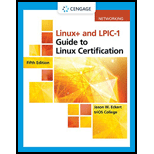
Computer Science: An Overview (13th Edition) (What's New in Computer Science)
13th Edition
ISBN: 9780134875460
Author: Glenn Brookshear, Dennis Brylow
Publisher: PEARSON
expand_more
expand_more
format_list_bulleted
Concept explainers
Question
Chapter 12, Problem 13CRP
Program Plan Intro
Turing machine:
Turing machine is used as a tool to understand the power of
Expert Solution & Answer
Want to see the full answer?
Check out a sample textbook solution
Students have asked these similar questions
I need help in explaining how I can demonstrate how the Laplace & Inverse transformations behaves in MATLAB transformation (ex: LIke in graph or something else)
You have made the Web solution with Node.js. please let me know what problems and benefits I would experience while making the Web solution here, as compared to any other Web solution you have developed in the past.
what problems and benefits/things to keep in mind as someone just learning
PHP is the server-side scripting language. MySQL is used with PHP to store all the data. EXPLAIN in details how to install and run the PHP/MySQL on your computer. List the issues and challenges I may encounter while making this set-up?
why I asked: I currently have issues logging into http://localhost/phpmyadmin/ and I tried using the command prompt in administrator to reset the password but I got the error LOCALHOST PORT not found.
Chapter 12 Solutions
Computer Science: An Overview (13th Edition) (What's New in Computer Science)
Ch. 12.1 - Prob. 1QECh. 12.1 - Prob. 2QECh. 12.1 - Prob. 3QECh. 12.1 - Prob. 4QECh. 12.2 - Prob. 1QECh. 12.2 - Prob. 2QECh. 12.2 - Prob. 3QECh. 12.2 - Prob. 4QECh. 12.2 - Prob. 5QECh. 12.3 - Prob. 1QE
Ch. 12.3 - Prob. 3QECh. 12.3 - Prob. 5QECh. 12.3 - Prob. 6QECh. 12.4 - Prob. 1QECh. 12.4 - Prob. 2QECh. 12.4 - Prob. 3QECh. 12.5 - Prob. 1QECh. 12.5 - Prob. 2QECh. 12.5 - Prob. 4QECh. 12.5 - Prob. 5QECh. 12.6 - Prob. 1QECh. 12.6 - Prob. 2QECh. 12.6 - Prob. 3QECh. 12.6 - Prob. 4QECh. 12 - Prob. 1CRPCh. 12 - Prob. 2CRPCh. 12 - Prob. 3CRPCh. 12 - In each of the following cases, write a program...Ch. 12 - Prob. 5CRPCh. 12 - Describe the function computed by the following...Ch. 12 - Describe the function computed by the following...Ch. 12 - Write a Bare Bones program that computes the...Ch. 12 - Prob. 9CRPCh. 12 - In this chapter we saw how the statement copy...Ch. 12 - Prob. 11CRPCh. 12 - Prob. 12CRPCh. 12 - Prob. 13CRPCh. 12 - Prob. 14CRPCh. 12 - Prob. 15CRPCh. 12 - Prob. 16CRPCh. 12 - Prob. 17CRPCh. 12 - Prob. 18CRPCh. 12 - Prob. 19CRPCh. 12 - Analyze the validity of the following pair of...Ch. 12 - Analyze the validity of the statement The cook on...Ch. 12 - Suppose you were in a country where each person...Ch. 12 - Prob. 23CRPCh. 12 - Prob. 24CRPCh. 12 - Suppose you needed to find out if anyone in a...Ch. 12 - Prob. 26CRPCh. 12 - Prob. 27CRPCh. 12 - Prob. 28CRPCh. 12 - Prob. 29CRPCh. 12 - Prob. 30CRPCh. 12 - Prob. 31CRPCh. 12 - Suppose a lottery is based on correctly picking...Ch. 12 - Is the following algorithm deterministic? Explain...Ch. 12 - Prob. 34CRPCh. 12 - Prob. 35CRPCh. 12 - Does the following algorithm have a polynomial or...Ch. 12 - Prob. 37CRPCh. 12 - Summarize the distinction between stating that a...Ch. 12 - Prob. 39CRPCh. 12 - Prob. 40CRPCh. 12 - Prob. 41CRPCh. 12 - Prob. 42CRPCh. 12 - Prob. 43CRPCh. 12 - Prob. 44CRPCh. 12 - Prob. 46CRPCh. 12 - Prob. 48CRPCh. 12 - Prob. 49CRPCh. 12 - Prob. 50CRPCh. 12 - Prob. 51CRPCh. 12 - Prob. 52CRPCh. 12 - Prob. 1SICh. 12 - Prob. 2SICh. 12 - Prob. 3SICh. 12 - Prob. 4SICh. 12 - Prob. 5SICh. 12 - Prob. 6SICh. 12 - Prob. 7SICh. 12 - Prob. 8SI
Knowledge Booster
Learn more about
Need a deep-dive on the concept behind this application? Look no further. Learn more about this topic, computer-science and related others by exploring similar questions and additional content below.Similar questions
- Capsim Team PowerPoint Presentations - Slide Title: Key LearningsWhat were the key learnings that you discovered as a team through your Capsim simulation?arrow_forwardWrite the SQL code that permits to implement the tables: Student and Transcript. NB: Add the constraints on the attributes – keys and other.arrow_forwardDraw an ERD that will involve the entity types: Professor, Student, Department and Course. Be sure to add relationship types, key attributes, attributes and multiplicity on the ERD.arrow_forward
arrow_back_ios
SEE MORE QUESTIONS
arrow_forward_ios
Recommended textbooks for you
 C++ Programming: From Problem Analysis to Program...Computer ScienceISBN:9781337102087Author:D. S. MalikPublisher:Cengage LearningProgramming Logic & Design ComprehensiveComputer ScienceISBN:9781337669405Author:FARRELLPublisher:Cengage
C++ Programming: From Problem Analysis to Program...Computer ScienceISBN:9781337102087Author:D. S. MalikPublisher:Cengage LearningProgramming Logic & Design ComprehensiveComputer ScienceISBN:9781337669405Author:FARRELLPublisher:Cengage C++ for Engineers and ScientistsComputer ScienceISBN:9781133187844Author:Bronson, Gary J.Publisher:Course Technology Ptr
C++ for Engineers and ScientistsComputer ScienceISBN:9781133187844Author:Bronson, Gary J.Publisher:Course Technology Ptr LINUX+ AND LPIC-1 GDE.TO LINUX CERTIF.Computer ScienceISBN:9781337569798Author:ECKERTPublisher:CENGAGE L
LINUX+ AND LPIC-1 GDE.TO LINUX CERTIF.Computer ScienceISBN:9781337569798Author:ECKERTPublisher:CENGAGE L Systems ArchitectureComputer ScienceISBN:9781305080195Author:Stephen D. BurdPublisher:Cengage Learning
Systems ArchitectureComputer ScienceISBN:9781305080195Author:Stephen D. BurdPublisher:Cengage Learning Principles of Information Systems (MindTap Course...Computer ScienceISBN:9781285867168Author:Ralph Stair, George ReynoldsPublisher:Cengage Learning
Principles of Information Systems (MindTap Course...Computer ScienceISBN:9781285867168Author:Ralph Stair, George ReynoldsPublisher:Cengage Learning

C++ Programming: From Problem Analysis to Program...
Computer Science
ISBN:9781337102087
Author:D. S. Malik
Publisher:Cengage Learning

Programming Logic & Design Comprehensive
Computer Science
ISBN:9781337669405
Author:FARRELL
Publisher:Cengage

C++ for Engineers and Scientists
Computer Science
ISBN:9781133187844
Author:Bronson, Gary J.
Publisher:Course Technology Ptr

LINUX+ AND LPIC-1 GDE.TO LINUX CERTIF.
Computer Science
ISBN:9781337569798
Author:ECKERT
Publisher:CENGAGE L

Systems Architecture
Computer Science
ISBN:9781305080195
Author:Stephen D. Burd
Publisher:Cengage Learning

Principles of Information Systems (MindTap Course...
Computer Science
ISBN:9781285867168
Author:Ralph Stair, George Reynolds
Publisher:Cengage Learning